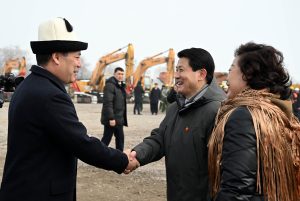Neighboring countries should ideally interact as equals, yet this is rarely true in global geopolitics. China and Kyrgyzstan are a case in point. The relationship between the two countries is heavily skewed in favor of Beijing, as Bishkek is deeply indebted to its neighbor and depends on it for future economic growth and development via the Belt and Road Initiative (BRI).
Debt will continue to be the Sword of Damocles hanging above Bishkek for the foreseeable future. The country’s accumulated debt is estimated to be $6.2 billion, including approximately $1.7 billion owed to China’s Export and Import Bank. According to Voice of America, the loans have been used for “infrastructure projects as part of Beijing’s global BRI,” including modernizing Bishkek’s central heating station, reconstructing the North-South highway, and renovating the country’s electrical grid.
According to media reports, Beijing has refused to renegotiate the debt or accept alternative methods of payment offered by Bishkek. There is societal concern about “what China will do if Kyrgyzstan fails to repay its debt,” as Voice of America phrased it. In addition to China potentially seizing major Kyrgyz assets as collateral, another potential scenario involves a new wave of anti-Chinese protests. Protests against Chinese investment and influence in Kyrgyzstan occurred in 2019 and 2020, including alleged calls to ban Kyrgyz-Chinese marriages.
On the one hand, China and the BRI have aided Kyrgyzstan in opening up to global trade. As a developing country in the heart of Eurasia, Kyrgyzstan has limited development and partnership options. When China formally launched the BRI in 2013, Kyrgyzstan swiftly joined the mega project to secure investment and infrastructure to break out of its geographical isolation and economic stagnation. In certain respects, the Kyrgyz partnership with the BRI has led to positive outcomes: BRI projects have improved domestic and international transit and have contributed to increased foreign trade. Infrastructure projects have also provided jobs to Kyrgyz citizens.
On the other hand, debt and dependency on Chinese loans are alarming. Beijing’s tendency toward exploiting other countries and pumping them out of resources does not help improve China’s image. It is debatable whether the BRI has become a project that is, as Lee YingHui wrote in The Diplomat in 2017, “too big to fail.” Nevertheless, even if the BRI falls short of expectations, small infrastructure upgrades to the Kyrgyz arteries of BRI trade corridors could still lead to China’s dominance of the country in political and economic terms, as well as to an increase in the flow of Chinese labor migration at the expense of the Kyrgyz workforce.
Despite societal opposition toward China and the BRI, Bishkek will continue to rely on Beijing for investment and trade in the foreseeable future. China has become the indispensable trade partner for Kyrgyzstan. In 2023, China was Kyrgyzstan’s top trade partner, comprising approximately $5.5 billion, or a 35 percent share of Kyrgyzstan’s annual trade turnover total of $15.7 billion. Furthermore, China is integrating itself into Kyrgyz affairs through transport and logistics projects.
This past January, the Chinese news agency China.org.cn reported that a third checkpoint between China and Kyrgyzstan, the Bedel Pass, will be opened later this year. The location of the pass is strategic, as it is some 70 km from Wushi County and Aksu County in Xinjiang, some 80 km from Karakol in Kyrgyzstan, and only 350 km from Kazakhstan’s largest city, Almaty. Construction of the pass includes “border crossing infrastructure and the creation of smart checkpoints” to speed up customs clearance processes and customs cargo clearance capabilities.
Another notable project is the China-Kyrgyzstan-Uzbekistan (CKU) railway, which could benefit Kyrgyzstan by providing jobs and offering a new option to reach neighboring countries and markets. However, the project will also ensure Bishkek remains indebted to Beijing, as Kyrgyzstan cannot finance the necessary infrastructure independently.
A 2023 report on Kyrgyzstan by the State Department’s Bureau of Economic and Business Affairs acknowledged President Sadyr Japarov’s “desire to attract greater, more diversified foreign direct investment (FDI) and to develop the IT, creative, and green economy sectors to contribute to sustainable economic growth.” However, for all his talk about diversifying the country’s economy and attracting new investors, Japarov has regularly praised his country’s relations with China and has maintained high-level contact with Beijing. On February 28, 2024, the Kyrgyz president attended a ceremony marking the start of construction of a vehicle factory that could produce up to 80,000 vehicles annually. Unsurprisingly, the project is a joint investment with a Chinese partner, Hubei Zhuoyue Group.
The future looks problematic for Kyrgyzstan, and helping it escape the Chinese debt trap will not be easy, particularly since the international community is focused on, and investing in, more visibly pressing global hot spots and conflict zones.
Nevertheless, a few countries have explicitly stated their intentions to develop closer relations with Kyrgyzstan. In the case of Kyrgyzstan-U.S. relations, the historic presidential C5+1 summit in 2023 concluded with the New York Declaration, which acknowledged “increased access to global markets and attracting sustainable international investment to Central Asia.” Moreover, in March 2024, the first-ever B5+1 Business Forum took place in Almaty to promote connectivity between U.S. and Central Asian businesses and entrepreneurs.
Despite these promising initiatives, it will take time and some luck before greater U.S. investment and trade with Kyrgyzstan occurs. Trade between the two nations reached $128.5 million in 2023, which is still very far from the volume of Sino-Kyrgyz trade.
Another contender for enhanced ties with Kyrgyzstan is the United Kingdom. On April 22, British Foreign Secretary David Cameron visited Kyrgyzstan with a straightforward message: “We’re saying we are a new partner that is keen to work with you with common interests, where we can make success together,” he told RFE/RL.
U.S. and U.K. engagement with Kyrgyzstan, though limited in scope, indicates that Bishkek is nevertheless attracting extra-regional attention. However, pulling Kyrgyzstan out of China’s orbit will not be easy – or cheap – and potential partners must be aware of these challenges when seeking to foster closer relations with Kyrgyzstan.
































